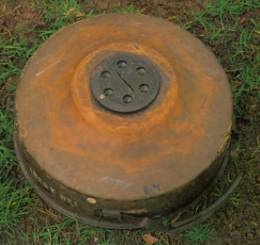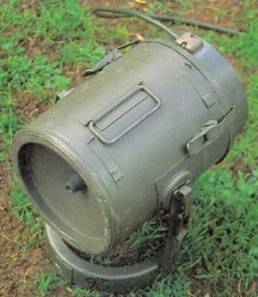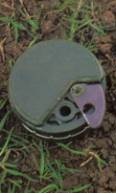MINE WARFARE AND DEMOLITION
MINE, ANTI-TANK Mk7

| Weight: | 14.7kg | Height: | 0.669m |
| Diameter: | 0.325m | Charge Weight: | 8.9kg |
| Detonation Weight: | 4.0kg | Date in Service: | nk |
The Mine, Anti-tank Mk7 is a WW2 design which was originally a pressure detonation mine, which had it's service life
extended by replacing the pressure plate detonator with a frangible carbon rod mast sensor.
The mine has a metal case, easily detectable by modern metallic mine detectors, and is laid by the traditional "shovel and hand"
method, but is still a very effective anti-tank weapon.
The mine was detonated by a pressure weight of 275kg, but the new carbon rod system detonates the mine when a tank or vehicle
breaks the rod releasing a spring-loaded detonator. The main charge is TNT.
MINE, ANTI-TANK, NON-METALLIC L3A1
| Weight: | 7.7kg | Height: | 0.145m |
| Diameter: | 0.266m | Charge Weight: | 8.9kg |
| Detonation Weight: | 6.0kg | Date in Service: | nk |
The L3A1 has a rubber casing and is a pressure plate mine, detonated by a weight of between 120 & 200kg. The charge is
TNT and the mine is armed by turning a simple lever device, and is disarmed in the same way.
OFF-ROUTE ANTI-TANK MINE (ORATM)

| Weight: | 13kg | Height: | 0.330m |
| Diameter: | 0.185m | Charge Weight: | nk |
| Detonation Weight: | n/a | Date in Service: | nk |
The ORATM was originally a French design known as the MIACAH. The mine operates horizontally across a route likely to be
used by enemy armour or other vehicles. A wire was rigged across the route and when crossed by a vehicle, the mine fires a
hollow charge which penetrates the side armour.
The mine is effective up to 80 metres and is extremely accurate.
A replacement ORATM is under development which uses the projectile from the LAW 80.
RANGER

| Weight: | 647kg | Height: | 1.3m |
| Diameter: | 0.062 | Charge Weight: | 0.10kg |
| Detonation Weight: | 2.1kg | Date in Service: | nk |
The Ranger is an Anti-personnel mine system designed to rapidly deploy a large numbers of small mines to delay an enemy
advance. The Ranger can also "over-sow" an anti-tank minefield to delay clearence. The Ranger is a vehicle based deployment
system which can launch the mines to a maximum range of 140 metres.
Ranger Anti-personnel Mine System mounted on FV13801

Each discharger tube holds 18 mines and a magazine holds 72 mines. 18 magazines are loaded into the disharger so that
1.296 mines can deployed in pre-programmed sequences.
Loading the magazine tubes

The Ranger system is usually mounted on FV432 APCs but can also be mounted on FV622 Stalwarts, FV13801 Bedfords or Combat
Support Boats.
L77A1 MINE DETECTOR No4C
The L77A1 No4C, was the standard mine detector of the British Army since 1968, has been replaced by the Ebinger
EBEX-420PB. The Army have designated the detector L77A1, NATO Stock Number 6665-99-869-3649. The L77A1 is a lightweight,
modular design which uses pulse induction technology to locate the metallic content of mines. The battery compartment and
electronics are built into the tubular structure, and an audible signal provided to the operator via a lightweight earpiece.
The sensitivity is such that even modern plastic mines with a minimal metallic content can be detected to a depth of 15cm.
The L77A1 weighs 6.5kg packed weight and 2.2kg deployed weight, and has a battery life of 45 hours